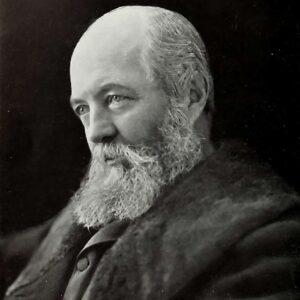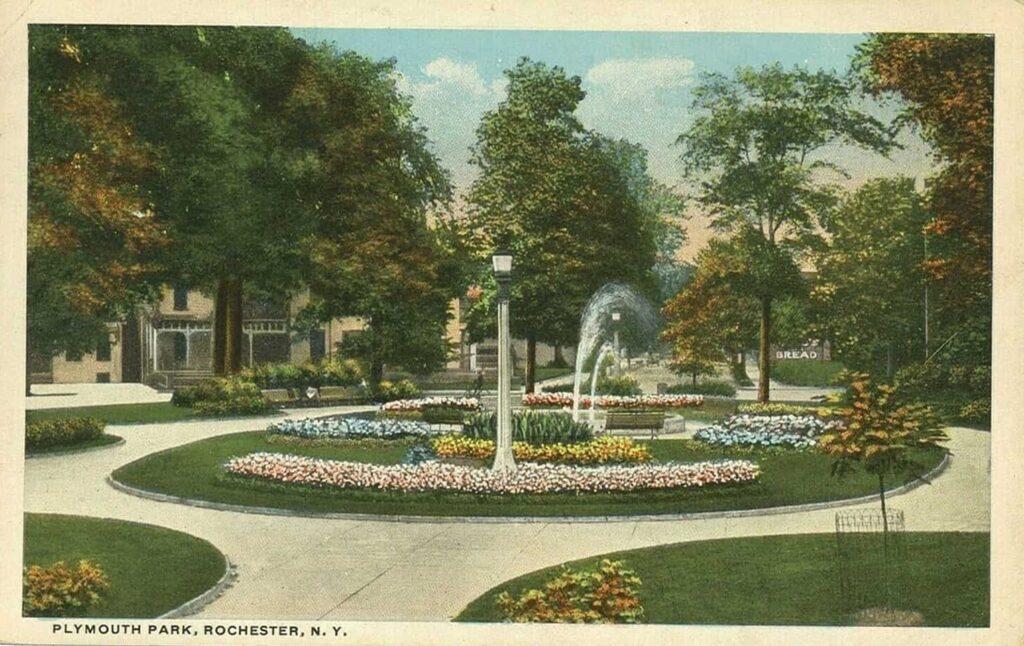Many of Rochester’s beautiful parks and parkways were designed in the 1880s by 19th century American landscape architect Frederick Law Olmsted. The most well-known of these include Highland, Genesee Valley, Seneca and Maplewood Parks. During his career, Olmsted created extraordinary urban green spaces across the country, including Central and Prospect Parks in New York, the Buffalo and Boston parkway systems, and Chicago’s Riverside Park. In April, parks and conservation organizations will be celebrating the 200th anniversary of Law’s birth.

In Rochester, plans for observing Olmsted200 include an exhibit at the Rochester Science Center and concerts at Genesee, Highland, Maplewood, and Seneca Parks. And yet small parks including our own Lunsford Circle Park, and Jones and Washington Parks, were also designed by Law, and we should claim of share in the celebration.
Olmsted’s Earlier Careers
Before Law found his true calling as a landscape architect, he was also a journalist. In that role, he first traveled to England where he saw the great parks he would later emulate in his own work. In the early 1850s, he was commissioned by the now New York Times to travel across the South to describe and assess the slave economy. The result was three volumes published between 1853 and 1860, in which he concluded that the slave economy was not only inefficient but wrong, only benefitted some 8000 owners of large plantations, impeded the quality of life and opportunity of its many more non-landowning white population, and reliant on the labor and deprivation of all its enslaved people.
According to the National Park Service’s biography of Law, in 1861, Union leaders asked Law to serve as Secretary General of the United States Sanitation Commission (later the American Red Cross), based on his administrative and logistical skills demonstrated in creating Central Park in the 1850s. His responsibilities included setting up field hospitals, supervising medical staff, distributing supplies, and fundraising. Due to overwork, he had to leave that position in 1863, but the plans and protocols he implemented were used to great effect for the duration of the war. After the war and for the rest of his career, he focused his energies on landscape design.
Origins of Lunsford Circle Park
The origins of Lunsford go back to 1824, less than ten years after Rochester’s founding, when Elisha Johnson, an engineer, and entrepreneur, named part of the Caledonia Tract as Caledonia Park. At that time, it was used as common land rather than as leisure space as we think of parks today. In 1837 it became Caledonia Square. In 1859 the square’s outline was redesigned as an oval, and became Plymouth Park, taking its name from the adjacent Plymouth Avenue (now Frederick Douglass St) along its northeast side. Its initial design was simple, with one path crossing the park parallel to the street, and later another path providing a diagonal.
In 1893, the Olmsted firm, consisting of Frederick and his sons, John Charles and Frederick Law Olmsted Jr., presented the city with their plans for redesigning Washington and Jones Squares and Plymouth Park. (Because Law retired in 1895 due to senility, it is not known how much input he had on this design. But his sons absolutely maintained their father’s design values in all their work.) Due to Plymouth Park’s small size and lack of landscape features such as waterways or hills that Law usually relied on to provide the pastoral and picturesque scenes he preferred, the firm had to take a different approach to creating ‘scenery.’ The solution: creating winding paths with elaborate plantings that created unique views within the park.

According to a report on Rochester’s Small Parks and Squares commissioned by the city in the late 1990s, the plan replaced the previous diagonal and rectangular patterns with winding paths and a greater variety of plantings. Trees were removed from the middle of the park so that the interior was bright and sunny. While keeping the original four entrances, the Olmsteds “transformed the space from the extreme simplicity of two crossing paths to a remarkably organic and curvilinearly-designed space.” Records and photographs show cultivated gardens along circular and elliptical walkways meant to draw people into the gardens. At the center of the park was an impressive fountain. The finished work demonstrated Olmsted’s goals of providing people with both a respite from city streets and a connection to the quiet beauty of the natural, if cultivated, world.
Lunsford Circle Park Today
However, by the 1940s the park had been neglected but had also become a very heavy traffic circle. By the 1950s the fountain, in particular, became too expensive to maintain and was filled with cement. In 1986, Mayor Thomas Ryan proclaimed Plymouth Circle Park, the “Dr. Charles Lunsford Circle Park.” The gazebo, donated by the Redemptorist Fathers when their church burned down, was relocated and restored by the Corn Hill Neighbors Association.
While the original elegance of Plymouth Park has been replaced by the informal and shady and nearly forested space of Lunsford, the circle has become the central hub and landmark for the neighborhood. It is a primary location for music during the annual Corn Hill Arts Festival in July, and for the CHNA’s summer music series. It is where people gather for the pre-festival picnic in June, and for ice cream and socializing on Neighborhood Night Out in August. Even during the last two years when the annual Christmas party at the Hervey-Ely House had to be canceled, neighbors met at the park to sing carols, this year accompanied by Rob Goodling on the keyboard, and share holiday greetings over hot cider and treats. And every day it provides a comfortable and comforting place for people of all ages to meet, visit with neighbors, or just sit on the swings and enjoy the day.

Observing Law’s Bicentennial In Corn Hill
We look forward to observing Law’s bicentennial and his message of conservation in April with our own concert. If you also have ideas for how we might celebrate Law and our park, please talk to friends and contact the editor at [email protected], Jeff Holdsworth, CHNA Board President, or Joanie Fraver, Board Vice President.
To Learn More About Frederick Law Olmsted’s Life and Career
Visit: https://olmsted200.org
CBS Interview With Dennis Drabelle
Watch below the CBS interview with Dennis Drabelle, author of “The Power of Scenery: Frederick Law Olmsted and the Origin of National Parks”:
